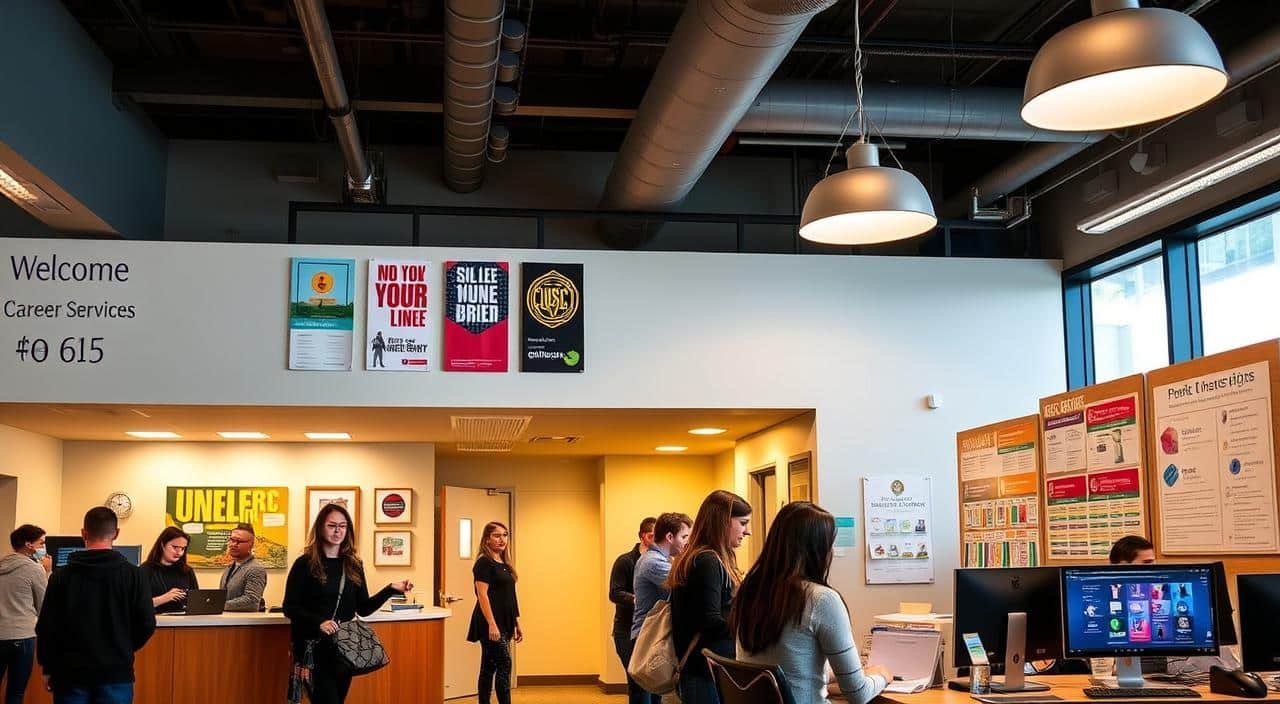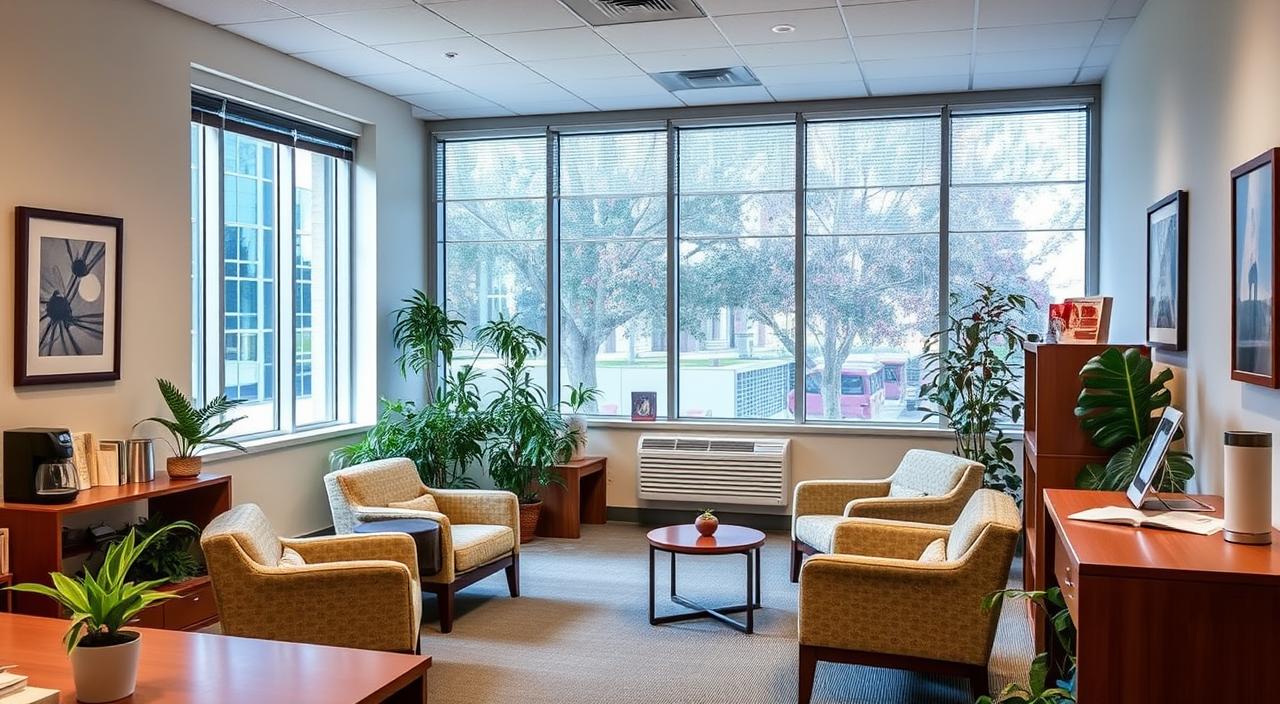At the heart of every thriving university lies a robust network of campus facilities. This vast infrastructure goes beyond mere classrooms. It includes buildings, laboratories, libraries, and recreational spaces.
This network plays a key role in shaping the educational experience. It also fosters a vibrant campus community. The facilities management team is dedicated to providing critical support services. They ensure the long-term sustainability and functional excellence of the campus environment.
From cutting-edge research laboratories to serene meditation rooms and state-of-the-art fitness centers, the facilities cater to diverse needs. These campus facilities support academic and intellectual pursuits. They also contribute to the overall well-being and sense of community on campus.
Key Takeaways
- Campus facilities encompass a vast network of buildings, laboratories, libraries, and recreational spaces that support the university’s mission and enhance the educational experience.
- The facilities management team is a skilled organization responsible for the long-term sustainability and functional excellence of the campus environment.
- Campus facilities cater to the diverse needs of the campus community, including academic, intellectual, and well-being requirements.
- Well-designed campus facilities can have a profound impact on student and teacher outcomes, promoting learning, collaboration, and overall campus life.
- As educational standards and student needs evolve, campus facilities must adapt to support 21st-century teaching and learning methods.
The Profound Impact of School Facilities
Research shows that school facilities greatly affect teachers and students. For teachers, the condition of the campus and available resources matter a lot. These factors influence their job satisfaction and how much effort they put in.
Facilities and Teacher Outcomes
Studies reveal that good facilities keep teachers in urban schools longer. Teachers prefer schools with modern, well-kept buildings. These environments support their teaching and make their work environment better.
Facilities and Student Outcomes
The school environment affects students’ health, behavior, and learning. Good classroom space, temperature, and natural light boost student performance. On the other hand, bad air and noise can hurt their focus and attendance.
The State of U.S. School Facilities
The condition of U.S. school facilities is a big worry. Most schools were built before 1970 and lack modern features. Improving facilities is key to supporting teachers and students’ needs.
“Poorly maintained classrooms negatively impact students and teachers,” noted the U.S. Department of Education in 2014.
Key Aspects of School Facilities

University facilities play a big role in supporting education and the well-being of students. They must focus on several important areas. These include acoustics, air quality, lighting, temperature, and classroom size and space.
Acoustics and Noise
Too much noise in schools can stress students and lower their focus. The EPA says schools with good maintenance have better attendance and fewer dropouts. It’s key to control noise for a better learning space.
Air Quality
Bad air in schools can make students miss school and feel sick. The EPA notes that better buildings lead to higher test scores. Keeping air quality high is vital for student health.
Lighting
Good lighting, natural and artificial, boosts mood and grades. Studies show students learn better in comfortable spaces. Well-lit classrooms improve the learning experience.
Temperature
Keeping the right temperature is important for learning. Good ventilation and lighting can cut down on illnesses. It’s crucial to manage temperature for a comfortable learning environment.
Classroom Size and Space
Too many students in a classroom can hold back learning. The National Center for Education Statistics says many schools need updates. Managing space well is key for modern teaching methods.
By focusing on these areas, universities can create a supportive learning environment. This environment fosters success, well-being, and a top-notch education.
Campus Facilities for 21st Century Learning

As education changes, campus facilities must too. They need to be flexible, tech-rich, and green. Spaces should support project-based learning, teamwork, and hands-on activities.
Classrooms should have lots of natural light. They should have different seating and be ready for digital tools. This helps students learn better.
Outdoor spaces, STEM labs, and career-focused areas are key for today’s students. They help students grow and get ready for the future. By updating campus facilities, universities can improve learning and meet student needs.
A study found many classrooms still look like they did a century ago. Schools need to change to fit today’s learning needs. It’s not just about looks or tech.
“The true shift should occur in the paradigm of learning and teaching, not just the physical space,” emphasizes Prakash Nair, an expert in educational facility design.
Educators, parents, and business leaders should check out Prakash Nair’s book. It explains how to make campus facilities for today’s students.
The University of Hawai’i at Hilo is a great example. They updated three classrooms to make them better for learning. This is part of a bigger plan to improve facilities.
The new classrooms have more outlets, new floors, and fresh paint. They have different seating, better audiovisual systems, and places for writing. These changes help students and teachers learn together better.
Campus Facilities: More Than Just Classrooms

Campus facilities today are more than just classrooms. Schools now have to fit in many programs. These include special education, early childhood, career-readiness, and standardized testing. Often, these needs are more than what old school buildings can handle.
Modern teaching focuses on teamwork, hands-on learning, and using technology. This means schools need flexible, tech-friendly spaces. Students also want places that offer emotional support, natural light, and outdoor areas.
Mandated Programming Takes Space
The campus community’s needs have grown. Schools must now have special areas for many programs. These include:
- Special education
- Early childhood education
- Career-readiness initiatives
- Standardized testing
Meeting these needs often means schools need to upgrade and grow. This is because traditional facilities can’t always keep up.
Teaching Happens Differently Today
Teaching methods have changed a lot. Today, classrooms focus on:
- Collaborative learning spaces
- Hands-on exploration and project-based activities
- Seamless integration of technology
These new teaching ways need flexible, tech-rich spaces. These spaces help support different teaching and learning styles.
Students Learn Differently Today
Today’s students have unique learning needs. They look for:
- Emotional support and well-being
- Exposure to natural light and outdoor settings
- Spaces that fit their individual learning styles
Updating campus facilities is key to meet these changing needs. It helps provide the quality spaces needed for success and growth.
Also Read: West Coast University Campus Life Overview
Conclusion
Campus facilities are key to helping students succeed and meet the mission of universities. Studies show how important good facilities are for teachers and students. They help create spaces that boost learning, health, and grades.
Universities need to keep up with changing education and student needs. They should focus on making facilities that are flexible, tech-savvy, and green. This way, they can give students a better learning experience and get them ready for today’s world.
The university’s smart money management has helped it grow its campus. It now has top-notch facilities that meet the changing needs of its community. The office of campus facilities works hard to keep the campus running well and sustainably. It aims to make the university a great place for students and teachers to learn and work.
FAQs
Q: What is the mission of the campus facilities administration?
A: The mission of campus facilities administration is to provide the campus community with a safe, clean, and sustainable environment that supports the academic and operational needs of university students and faculty.
Q: How does the university ensure sustainable operations in facility management?
A: The university strives for operational sustainability by implementing energy management practices, conserving resources, and overseeing construction projects that focus on reducing environmental impact.
Q: What types of facility resources are available to students and faculty?
A: Facility resources include classrooms, laboratories, study areas, and recreational spaces. The facilities services team is responsible for maintaining these resources to meet the needs of the university community.
Q: How can I submit a request for facility services?
A: You can submit a request for facility services by filling out a request form available on the university’s facilities management website. This form allows you to specify your needs for maintenance or other services.
Q: What role does the finance department play in campus facilities?
A: The finance department plays a crucial role in budgeting for construction projects, facility operations, and maintenance services to ensure that all facilities are well-funded and maintained effectively.
Q: How are landscape services integrated into campus facility planning?
A: Landscape services are an essential component of facilities planning, focusing on the design and maintenance of outdoor spaces that enhance the campus environment and support sustainability goals.
Q: What types of construction projects are currently underway on campus?
A: Current construction projects may include new academic buildings, renovations of existing facilities, and infrastructure improvements aimed at enhancing campus resources and operational efficiency.
Q: How does the university manage energy consumption across its facilities?
A: The university implements energy management strategies to monitor and reduce energy consumption in its facilities, promoting conservation and sustainability initiatives throughout the campus.
Q: Who oversees custodial operations in campus facilities?
A: The custodial operations are overseen by the facilities and operations team, which ensures that all university buildings are maintained at a high standard of cleanliness to provide a pleasant environment for visitors and the campus community.
Q: How does the campus facilities team support the university community’s needs?
A: The campus facilities team provides support by actively engaging with the university community to address facility needs, ensuring that all spaces meet the operational and educational requirements of students and faculty.
Source Links
- https://www.bestcolleges.com/blog/benefits-living-on-campus/
- https://kentlaw.iit.edu/law/student-experience/campus-facilities
- https://hope.edu/academics/biology/facilities-classrooms/index.html






